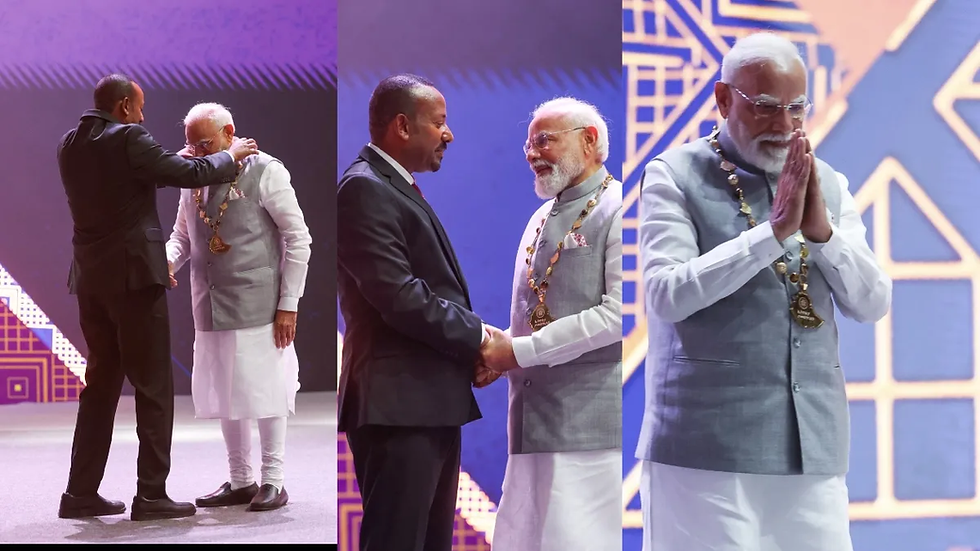PM Modi’s Japan Visit: A Decade-Long Roadmap for Stronger India–Japan Ties
- MGMMTeam

- Aug 29
- 3 min read
Prime Minister Narendra Modi’s two-day state visit to Japan has become a defining moment in the history of India–Japan relations. Marking his eighth trip since taking office, Modiji’s engagement with Japanese Prime Minister Shigeru Ishiba at the 15th Annual Summit and India–Japan Economic Forum opened a new chapter of strategic cooperation. The visit, held against the backdrop of global trade realignments and U.S. tariff challenges, showcased how India and Japan are determined to deepen their partnership for economic, technological, and geopolitical stability.

Investment Commitments and Economic Roadmap
One of the most significant takeaways from the summit was Japan’s announcement of an investment package worth ¥10 trillion (approximately $68 billion) over the next decade. This bold move aims to accelerate India’s industrial growth, particularly in advanced manufacturing, clean energy, digital infrastructure, and semiconductors. Both leaders presented a 10-year “roadmap” that identified economic security, innovation, environment, and health as key pillars of collaboration. This investment underscores Japan’s trust in India’s growth trajectory while solidifying India’s place as a hub for global supply chains.
India’s Call: Make in India, Make for the World
At the Economic Forum, Modiji reiterated his call to Japanese businesses to expand manufacturing in India under the banner of “Make in India, Make for the World.” He emphasized that India today offers not just a market but also a skilled workforce, political stability, and policy reforms that favor ease of doing business. This vision found resonance with Japanese leaders, who view India as an engine of growth in Asia. Together, both nations aim to lead a technological revolution by combining India’s human capital with Japan’s expertise in robotics, AI, and advanced manufacturing.
Technology, Space, and Innovation Partnerships
Technology and innovation emerged as central themes of the visit. The summit laid emphasis on cooperation in semiconductors, AI, clean energy, robotics, space, and mobility solutions. In a historic first, Prime Minister Modi announced that India’s space agency ISRO and Japan’s JAXA would collaborate on the Chandrayaan-5 lunar mission, marking a new era in Indo-Japanese space cooperation. The leaders also highlighted the role of green technology, with joint projects in sustainable fuels and environmental credit systems, reflecting a shared commitment to climate responsibility.
Workforce Mobility and People-to-People Ties
Acknowledging Japan’s aging population and India’s vast youth potential, the two governments signed agreements to facilitate the exchange of nearly 500,000 workers and students over five years. This initiative will not only help bridge Japan’s labor shortages but also strengthen cultural and academic ties between the two nations. Prime Minister Modi, while addressing the Indian diaspora in Tokyo, praised their contribution to Japanese society and encouraged them to become living bridges between the two cultures.
Strategic and Security Cooperation
Beyond economics, the summit reaffirmed India and Japan’s shared vision for security in the Indo-Pacific. Both sides agreed to deepen cooperation in defense, cybersecurity, supply chain resilience, and counterterrorism. The leaders jointly expressed their commitment to safeguarding free and open sea lanes, ensuring peace in the Indo-Pacific region, and countering threats from terrorism. Eleven agreements, including a joint statement on stability and peace, were signed to formalize these commitments.
Diplomacy in Action: Symbolism and Warmth
The visit was not limited to boardrooms and official documents. Modiji was welcomed warmly by the Indian community in Tokyo with cultural performances, symbolizing people’s faith in the growing friendship between India and Japan. In a symbolic gesture, he was presented with a traditional Japanese Daruma doll, representing perseverance and hope. Prime Minister Modiji also invited Shigeru Ishiba to India for the next annual summit, reaffirming that this cooperation is not just transactional but built on trust and mutual respect.
Geopolitical Context and Broader Asian Tour
The Japan visit is part of Modiji’s larger Asia strategy to strengthen regional alliances as U.S. tariffs weigh heavily on Indian exports. From Tokyo, Modiji will travel to Tianjin, China, for the Shanghai Cooperation Organisation (SCO) summit, where he is expected to meet Chinese President Xi Jinping and Russian President Vladimir Putin. This balancing act demonstrates India’s pursuit of strategic autonomy and its ability to build bridges across rival blocs in a changing global order.
Conclusion
Prime Minister Modi’s visit to Japan has set a powerful precedent for the future of India–Japan relations. With a decade-long investment roadmap, enhanced technological collaboration, expanded workforce exchanges, and renewed defense partnerships, the visit symbolizes a maturing alliance that goes beyond economics. It is a partnership built on trust, innovation, and a shared vision for regional peace and prosperity. As global trade dynamics shift, the deepening India–Japan bond could well become one of the most decisive relationships shaping Asia’s future.
(Sources: Firstpost, Hindustan Times, AP News)




Comments